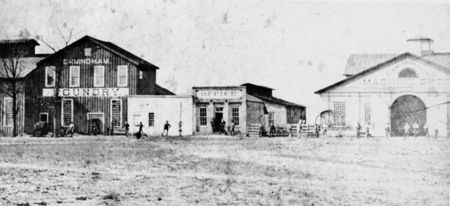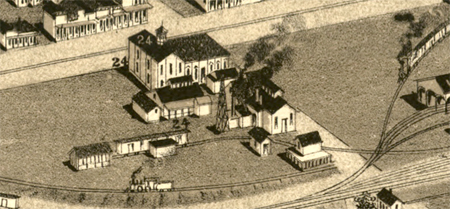Linn Iron Works
The Linn Iron Works (originally the Birmingham Foundry & Car Manufacturing Company) was established in 1875 by former merchant turned banker Charles Linn. It covered the block between 13th and 14th Streets North and 1st Avenue North and the Railroad Reservation.
Linn purchased machinery used at the former Irondale furnace from Joseph Johnston, who was converting the site into a farm and orchard.
In 1886, the iron works was acquired by the Tennessee Coal, Iron and Railroad Company (TCI). In their 1900 Description of Plants and Mines with Illustrations, TCI described the Linn Iron Works:
This property of the Company is located in the heart of the City of Birmingham, on First avenue, between Thirteenth and Fourteenth streets, and includes the whole block, 400 feet square. On this are located a machine and pattern shop of brick 175 by 60 feet, a boiler shop 142 by 52 feet, a blacksmith shop 52 by 40 feet, a locomotive shop 46 by 112 feet, a brass foundry 29 by 95 feet, boiler and power plant, etc., and a brick office and supply house.
The Birmingham Southern Railroad has a spur track into the works from its main line, thus giving the works a direct connection with all the Company's plants at Ensley, Pratt City and Alice Furnaces. In addition, this railroad makes connection just outside the works with all the railroads of the District.
The works do all the heavy repair work for the various plants of the Company in the District, and in addition as much outside work as they can profitably handle.
In addition to repair work, these works have done a large amount of construction, such as blowing and hoisting engines, furnace parts, boilers and stacks, iron roofs, etc.
Superintendent L. A. Brooks resigned from the iron works in July 1888, after six years' tenure, to become general manager of the Ensley Coal & Iron Co. of Sheffield.
The works fell under the management of engineer Erskine Ramsay when he was made Assistant General Manager for the Tennessee company in 1895. He perfected many of his mining equipment innovations there, many of which were adopted throughout the region and in other mining districts worldwide.
The works eventually closed, with the southern half of the block becoming the site of the Birmingham Southern Railroad freight depot around 1928.
References
- "Brooks' Good Luck" (July 25, 1888) The Weekly Herald, p. 3
- Description Of Plants And Mines With Illustrations. (July 1900). Birmingham: Tennessee Coal, Iron And Railroad Company - accessed via Google Books on June 30, 2010.
- Armes, Ethel (1910) The Story of Coal and Iron in Alabama. Birmingham: Birmingham Chamber of Commerce

